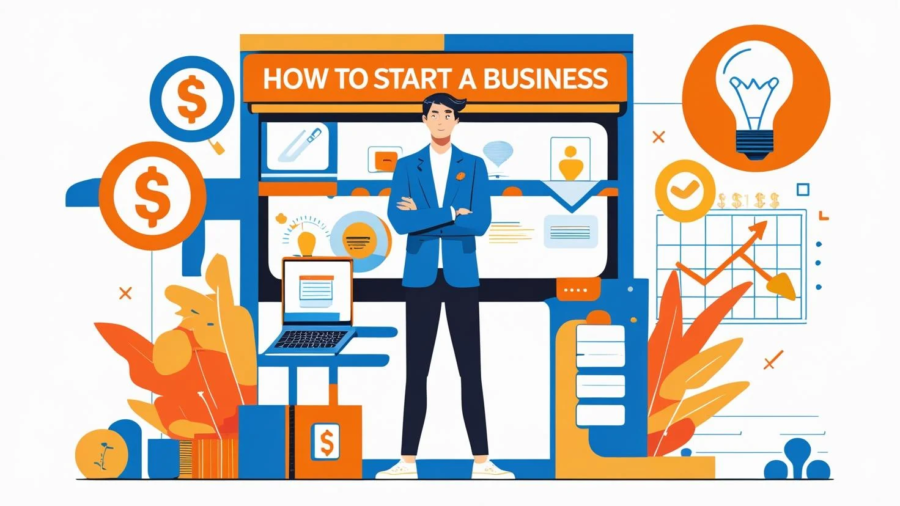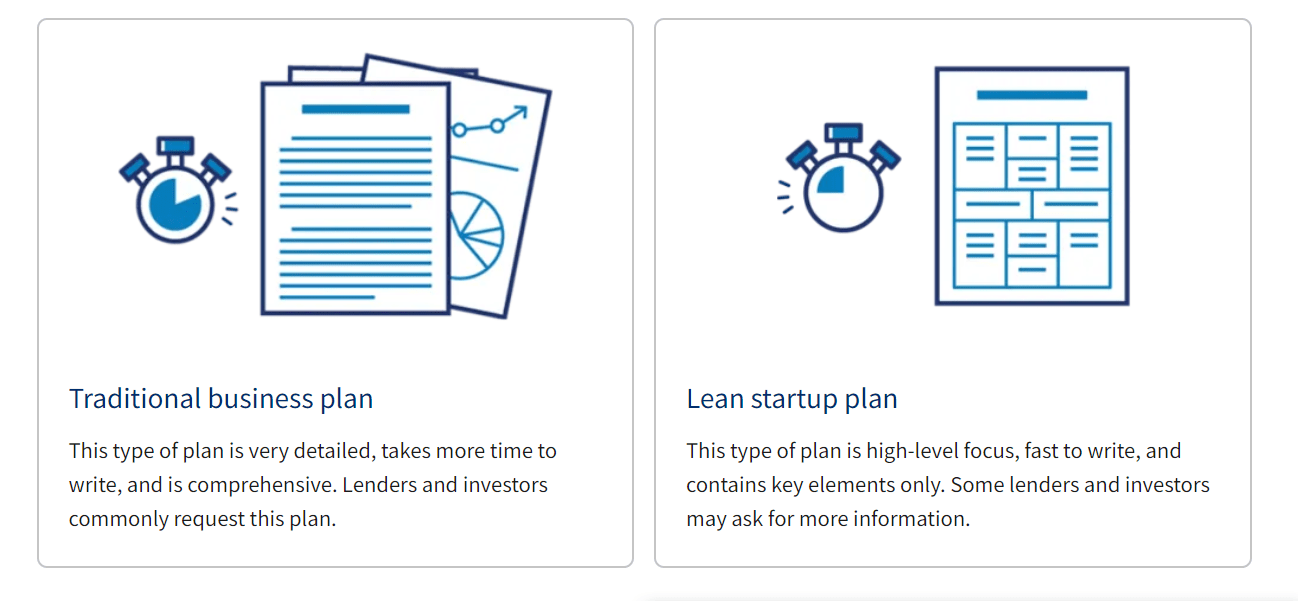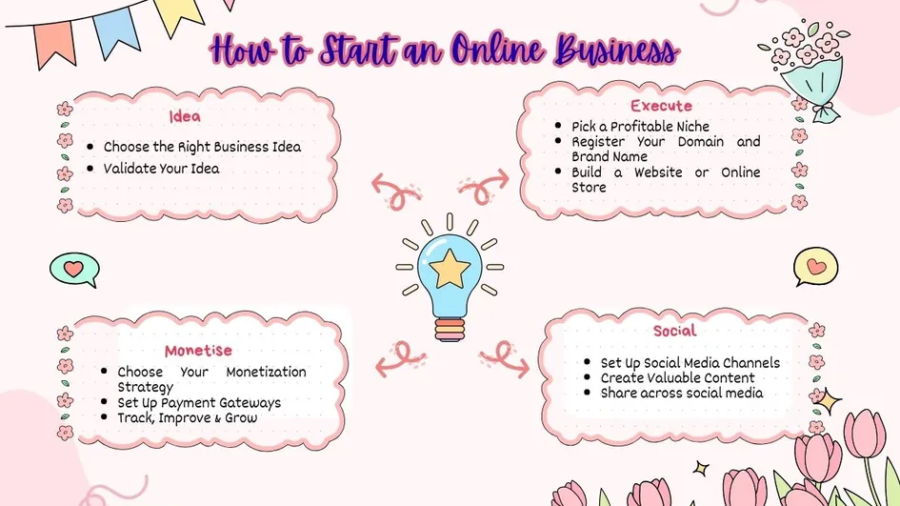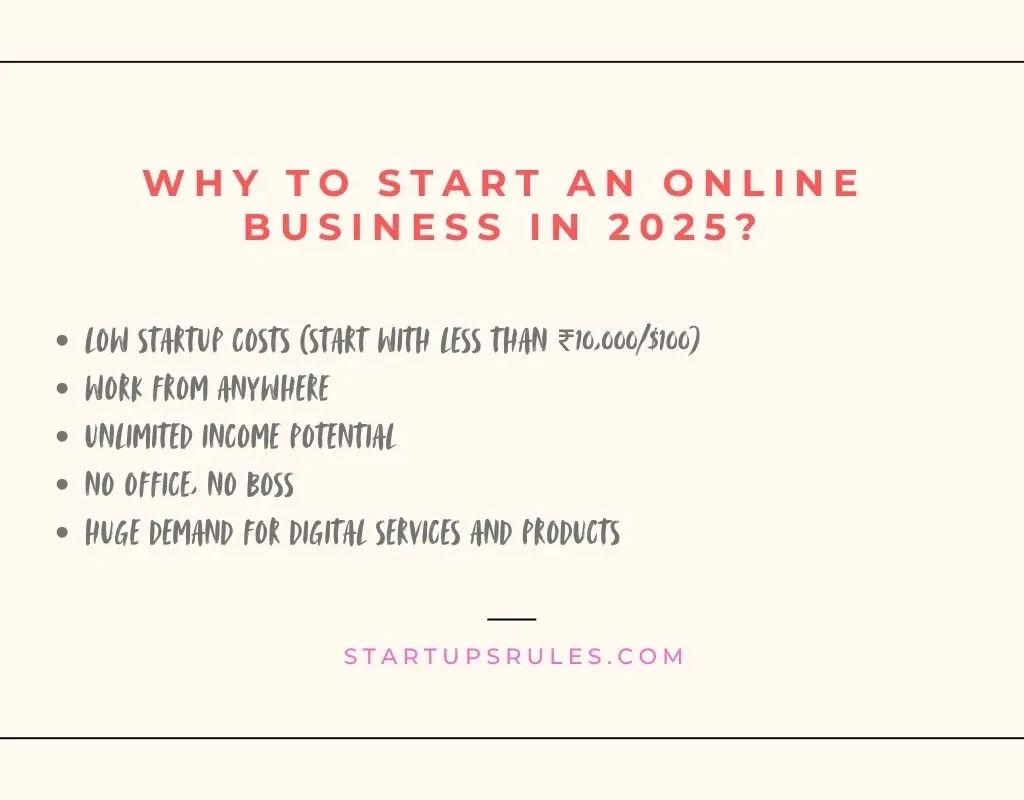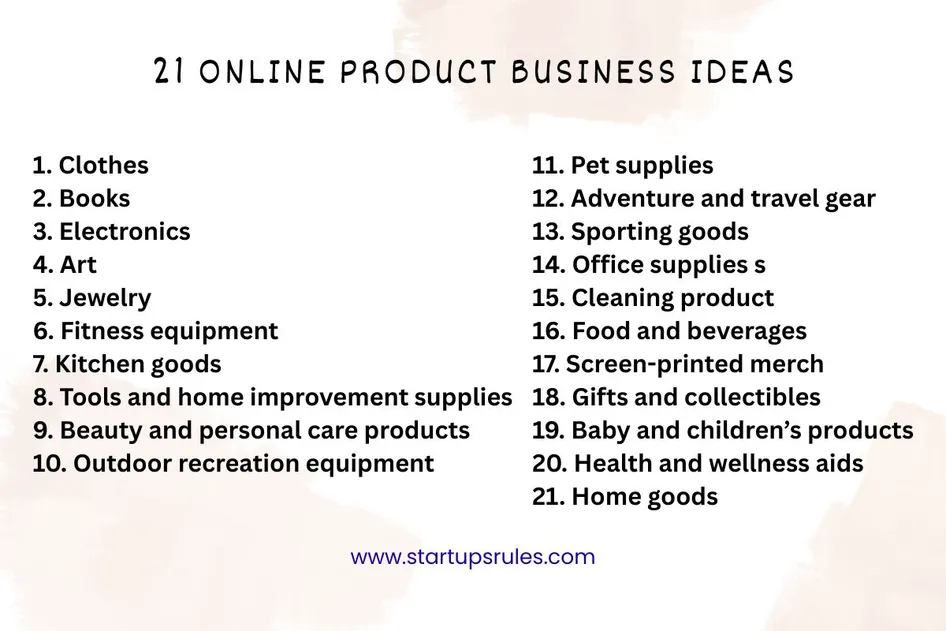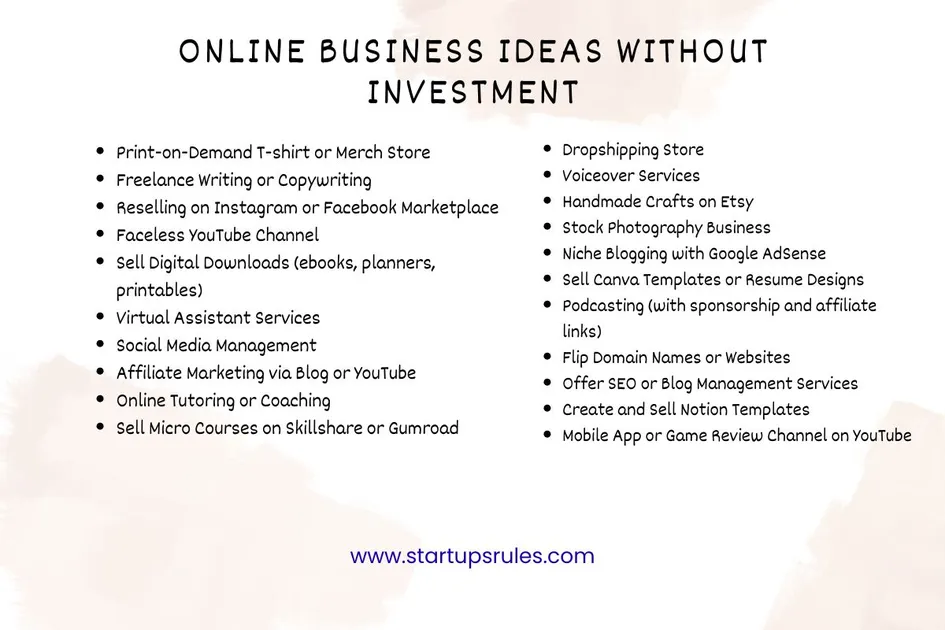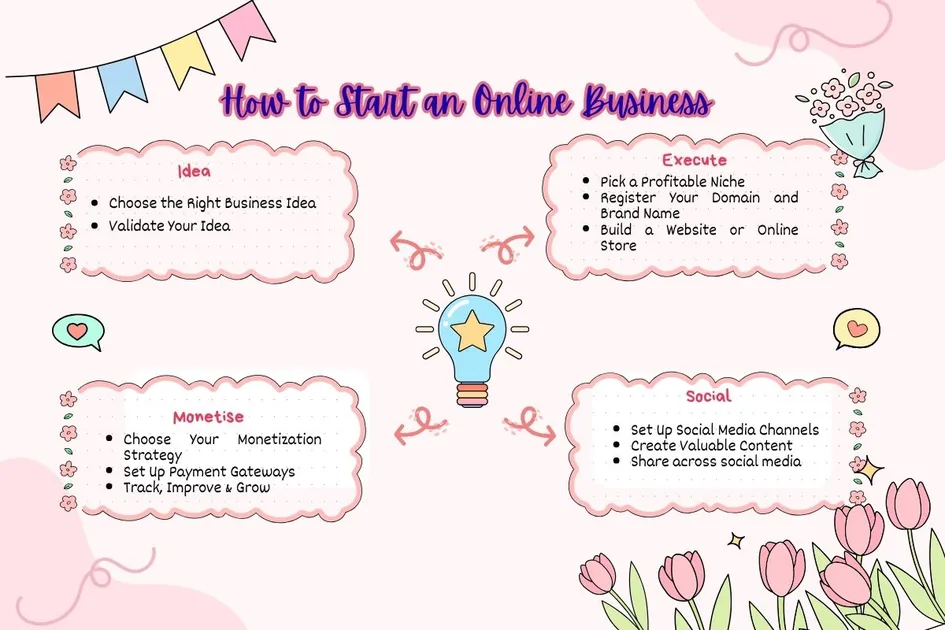Hey there! If you’ve ever thought, “I want to start my own business, but you have no Idea how to start a Business,” then you’re at the right place. I have been helping small businesses to build and grow businesses for over 5 years, and In this Blog Post I am going to break it step by step — How to start your own Business, in the most simple, practical way possible.
In this post you will Learn how to launch your own business with our step-by-step guide on how to start a business in 2025? From why to start your business, business idea to business planning to marketing, we share the best tips and strategies to help entrepreneurs reach success.
So, what is a business, really? A business is simply solving a problem in a way people are willing to pay for. That’s it. You help people, and they give you money. Sounds simple, right? there are 3 Core Keys to Every Business:
- A problem worth solving
- A solution that works
- People who want that solution and are willing to pay for it
You don’t need to invent next generation product, Sometimes just offering homemade food to office workers or students, teaching students online can be a successful business if done right way.
What should you do your favorite Job or Business? Read this Complete Guide.
How to start a Business?
I have divided this complete guide into 5 parts-
- How to choose right Business Idea?
- How to plan your Business?
- How to Launch your Business?
- How to Manage your Business?
- How to Grow your Business?
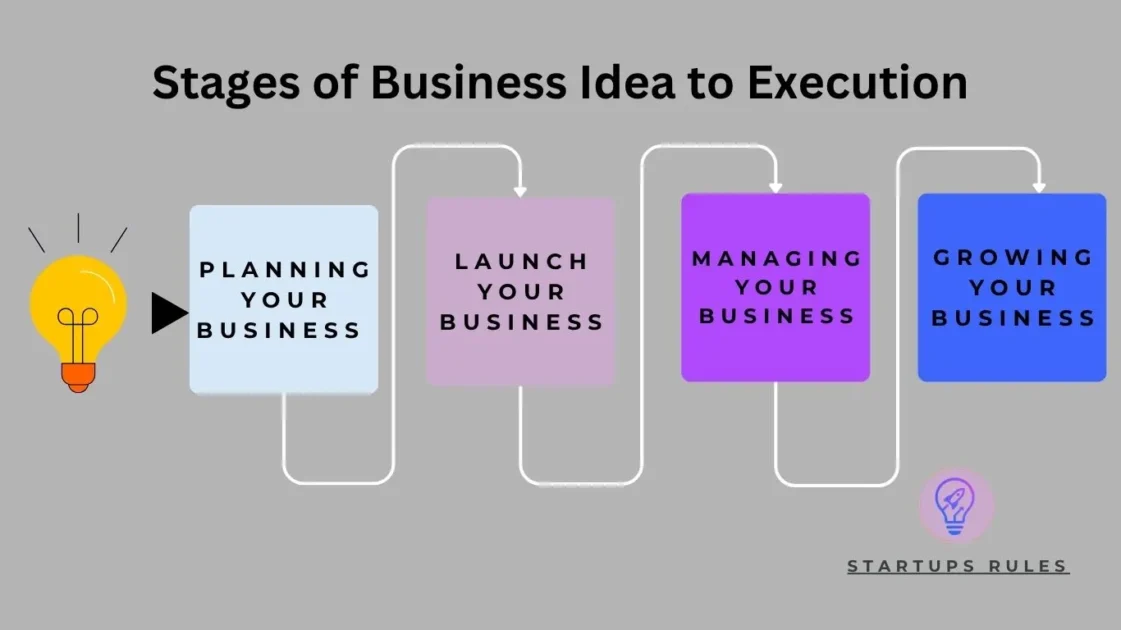
1. How to choose right Business Idea?
Every successful business starts with one thing: an idea. That idea might be a unique product, a helpful service, or simply a better way to do something that already exists.
“Should I start something completely new business idea, or copy an existing business idea but improve it by finding the gaps?”
New Business Idea: Building Something That Doesn’t Exist Yet. This is the bold, blue-ocean path. You come up with something truly original—a product or service that nobody else is doing.
Copying a Successful Idea—But Finding Gaps & Doing It Better. This is the smart, underrated path most successful businesses take. You study what’s already working- What are products or services they selling? Who are they ignoring? Where are users complaining? How can I solve this better, faster, or cheaper?
This is called “Innovative Copying”—you take the foundational base, but you build a better house on that base. Generate Business Idea for your Business.
So, Which Business Idea Should You Pick?
If you’re new to business, go for: “Copy + Gap Finding” It’s safer, faster, and more profitable. Success comes not from ideas, but from execution. Most billion-dollar companies didn’t start with a brand new idea—they found a broken system and fixed it.
Remember this “Google wasn’t the first search engine. Facebook wasn’t the first social network. Amazon wasn’t the first e-commerce platform. They just did it better.”
If you’re experienced or have industry insight, try the “New Idea” route– But validate it first—build a prototype, talk to potential users, and see if real people actually want it.
Case study on copying a business idea- In India traditional IIT-JEE / AIIMS coaching industry in kota was dominated by ALLEN, Resonance etc. but Physicswala comes with an Idea to fill the gap so every student can afford quality education and started a edtech company for providing online coaching for IIT/AIIMS at very affordable prices and become multi million company within few years.
Similarly, Zepto in india started 10 minutes grocery delivery at home after proper market research and become billion dollar successful business.
How to start a Successful business – Best Business to start in 2025
How to start a small Business-50 Best Small Scale Business Ideas in 2025
How to start a online Business- 100 Most Profitable Online Business Ideas for 2025
Remember: The best business ideas are simple, specific, and solve a real problem. You don’t need to be a genius—you just need to pay attention, take action, and stay curious.
How to do Market Research to start a Business ?
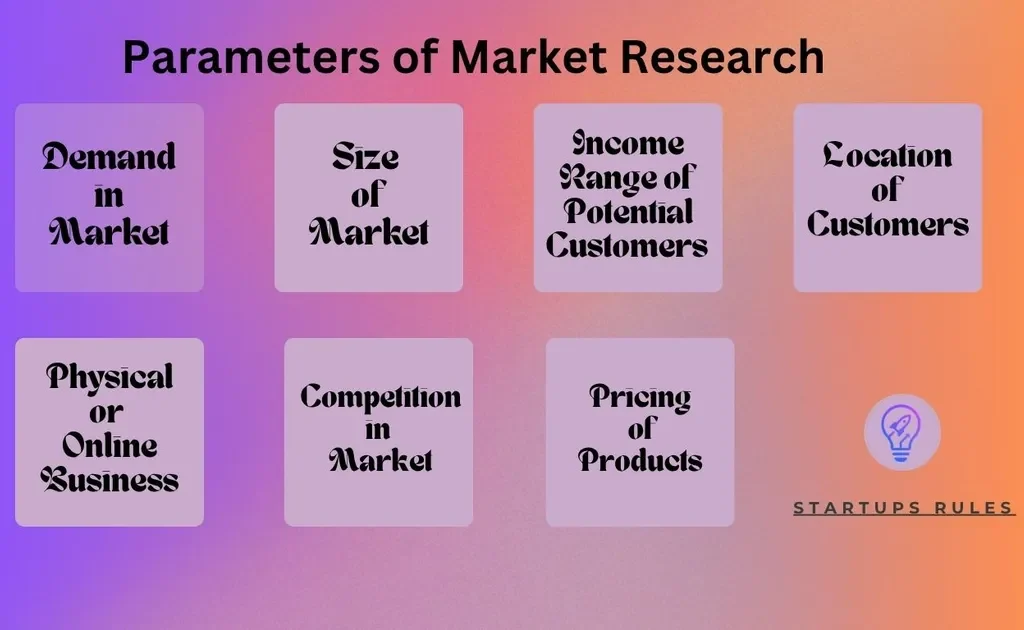
Read More- How to create Minimum Viable Product (MVP)?
Read More- How to Validate Your Business Ideas?
Before starting a business, Market research is one of the most important steps in validating a business idea. It combines consumer behavior with economic data to help you understand whether your business idea can succeed in your business niche. Before you build a product or service for your business, you need to understand who your potential customers are and what they really want.
Start by analyzing demand: is there a real need for what you’re offering? Then look at market size—how many people fit your ideal customer profile, and is that number growing or shrinking?
Dig deeper into demographics, such as age, income, education, family size, and occupation. These factors help you define your core audience. Go beyond the numbers and explore psychographics like interests, habits, values, and lifestyle—these tell you how your customers makes purchasing decisions. Study economic indicators like income levels and unemployment rates, which influence a customer’s purchasing power.
Your business location and reach are also important—can you serve customers locally, regionally, or globally? if your reach is global consumers then you should start a online business based on your product or service.
Next, assess market saturation: are there already too many businesses offering the same thing, or is there room for you to stand out? A strong competitive analysis can help here—study what your top competitors do well, where they fall short, and what customers are saying about them.
Pricing is another key factor. Understand what your potential customers currently pay for similar products or services, and what they’re willing to pay for something better. Keep an eye on industry trends, such as shifts in consumer behavior, technological advancements, or regulatory changes. Lastly, collect direct feedback from potential customers through surveys, polls, interviews, or test marketing. Combine all of this with trusted data sources like Google Trends, Statista, government databases, or industry reports.
Done well, market research helps you make smarter decisions, reduce risk, and position your business to meet real-world demand.
How to do market research and competition analysis properly?
How to choose a Business Name
Naming your Business is an important step that shows your business brand’s identity and your vision. It can feel overwhelming, but there are some tools that make the process simple and easy. You can use business name generators for inspiration or follow simple guidelines.
Choosing the right business name for your business is crucial for branding and discoverability. Keep it short and simple—names like Uber or Slack are easy to remember and spell. Avoid complicated or awkward spellings that can confuse users. Your name should be catchy and sound good when spoken aloud, like Zoom or Figma. Before finalizing, get feedback from others to gauge memorability and appeal.
Do internet search to ensure the name isn’t already taken, and check for domain and social media availability. Also, consider SEO potential—unique names like Zapier perform better in search results than generic ones.
Lastly, avoid overly specific names like “JustTShirtsNow,” which might limit future growth; instead, go for flexible names such as Threadly that can grow with your brand.
Read More- How to Choose unique Business Name
Check Business Name availability
How to Create Pitch Deck for your Business
Before asking funding for your business, you need a strong pitch deck—a presentation that tells the story of your business and convinces investors. A good pitch deck should start with a brief introduction to your Business, followed by the problem you’re solving and the solution your product or service going to offers. it should also Include details about the market size, your product description, growth goals. Also, provide a clear view of your financial plans and how you’ll use the investment funds for your business.
Download our Pitch Deck Guidelines and avoid any mistakes.
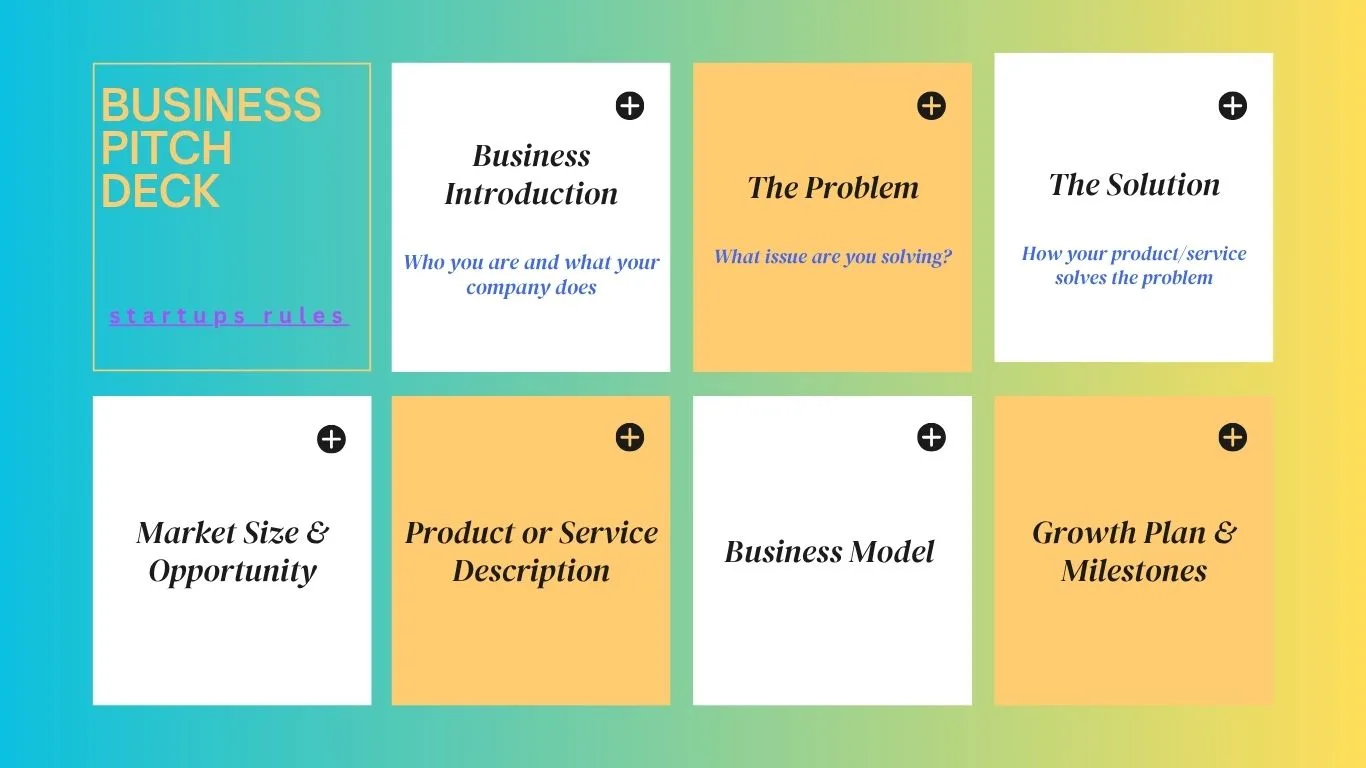
2. How to Write a Business Plan for Your Business?
What is a Business Plan? -A business plan is a roadmap that outlines how to start a business, how to run a business, and how to grow your business. It helps you stay organized and make strategic decisions. It’s also essential for attracting investors or partners, as it shows your business is well thought-out and has strong potential for success.
You might be thinking- How to write a business plan? What should a business plan contain? Which business plan is best for you? I have provided business plan summary here, You can also refer our Business plan templates, you can also design you own business plan templates in Canva.
Your business plan should have following information.
- Business Overview – A quick summary of your idea or company.
- About the Company – Name, location, founders, and your mission or goal.
- Industry Insight – What’s happening in your industry and who your competitors are.
- Target Customers – Who you’re selling to and how you’ll reach them.
- Team and Structure – Who’s running the business and what their roles are.
- Products or Services – What you’re offering now and in the future.
- Marketing and Sales Plan – How you’ll promote and sell your products.
- Money Plan (Finances) – Expected income, costs, and profits.
- Action Plan – Steps to reach your goals, with a timeline.
Which business plan is best for your business- Traditional business plan or lean startup plan.
Traditional Business plan vs. Lean Business Plans:
| Aspect | Traditional Business Plan | Lean Business Plan |
|---|---|---|
| Length | Very detailed (20–40+ pages) | Short and concise (1–2 pages) |
| Purpose | Used for investors, loans, or serious business planning | Used for internal use, quick testing, and flexibility |
| Time to Create | Takes a lot of time and research | Quick to create and easy to update |
| Includes | Full market analysis, financials, product details, etc. | Key elements only: vision, strategy, tactics, metrics |
| Best For | Established businesses or startups seeking funding | Startups experimenting with ideas or pivoting |
| Updates | Harder to change frequently | Easy to revise as business evolves |
Use a Traditional Business Plan when you need to secure funding or explain your business in detail. Use a Lean Business Plan when you’re just starting out, testing ideas, or need something fast and flexible.
Other than Business plan your business should also have Strategic Plan. Now you can ask What is Strategic Plan for a Business? A strategic plan outlines key steps and strategies to help a company achieve its goals. While startups often grow quickly, they can hit a plateau—strategic planning helps maintain and continue that growth by setting clear direction, tracking progress, and prioritizing resources for better ROI.
It also impresses investors (VCs) by showing goal clarity and motivates the team by offering a shared vision. Unlike a business plan—which is usually created early and covers the complete business model—strategic plans focus on guiding established businesses and need to be updated regularly as the business evolves. Strategic planning is a dynamic, ongoing process—not a one-time task.
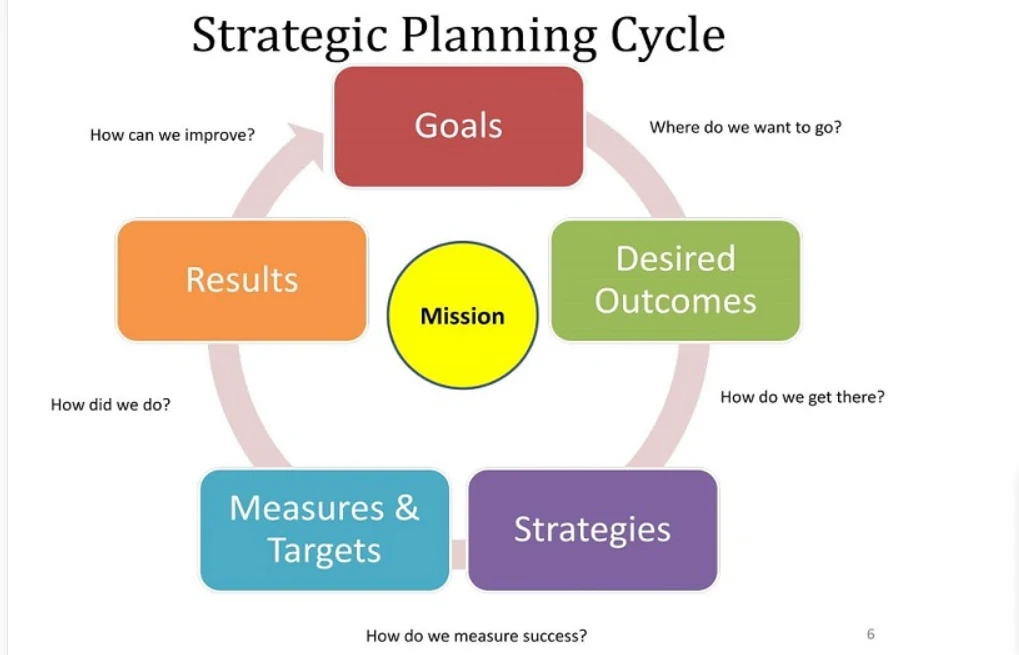
How to choose Business Structure?
Why Your Business Structure Matters
The structure you choose for your business affects almost every part of your business — from how you operate your business, to how you pay taxes, and even how much of your personal property is at risk. That’s why it’s important to select a right business structure that provides the right balance of legal protection, tax advantages, and flexibility to meet your future goals.
Which business structure is right for you–
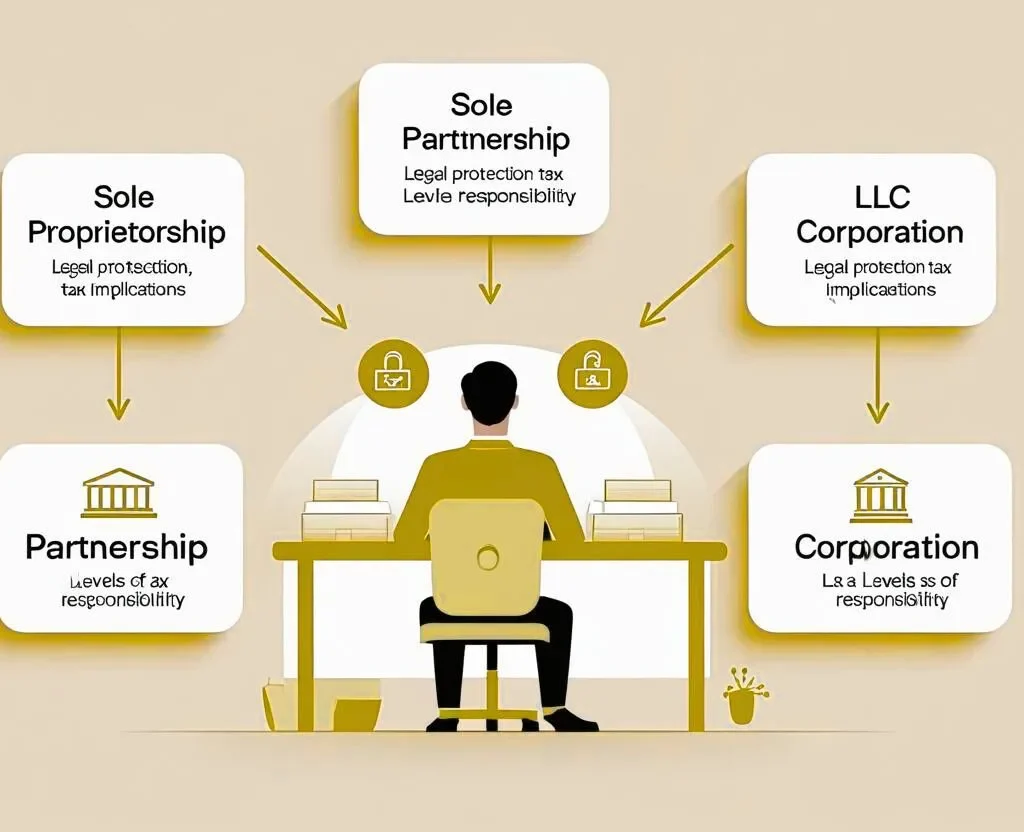
A Sole Proprietorship is the easiest and most common type of business to start. It requires no formal registration and gives the owner full control. However, the downside is that the business and the owner are legally the same, meaning personal assets are at risk for any business debts or legal actions. It’s ideal for low-risk ventures or solo entrepreneurs testing a new idea.
A Partnership is suitable when two or more people want to run a business together. There are two main types: Limited Partnerships (LP) and Limited Liability Partnerships (LLP). LPs include one general partner with full liability and others with limited roles and risks. LLPs offer limited liability to all partners and protect each from the actions of the others. This structure is often chosen by professionals like lawyers or accountants.
A Limited Liability Company (LLC) combines the liability protection of a corporation with the flexibility of a partnership. Owners (called members) are generally not personally liable for business debts, keeping personal assets safe. It’s a popular choice for many small and medium-sized businesses due to its balance of protection and simplicity.
Now that you’ve nailed down your business idea, built a minimum viable product (MVP), chosen a catchy business name, prepared a compelling pitch deck, structured a solid business plan, and decided on your business structure — it’s time for the next big leap: funding your business. 🚀
How to fund your Business?
Starting a business needs money, and choosing how to fund your business is one of your first big decisions. The way you get money can affect how you run and grow your business. Since every business is different, there’s no one right way to fund it. Your personal finances and your goals will guide your choice. Once you know how much money you need to start your business, the next step is to decide where it will come from.
There are several ways to fund a business, depending on your goals and resources.
Bootstrapping means using your own money, which gives you full control but can be risky. Crowdfunding helps you raise funds online while testing your idea publicly.
Grants, especially from the government or private organizations, are great since they don’t need to be paid back. Credit cards can offer short-term financing and help build credit if used wisely.
A small business loan from a bank or lender is another option, provided you have solid financial projections. Business lines of credit work like personal loan, credit cards, giving you flexible access to funds as needed.
Finally, angel investors—wealthy individuals who invest early in startups—can offer both funding and mentorship. Each method has pros and cons, so choose based on your situation and business stage.
This is where your dream starts turning into reality. Whether you’re bootstrapping, reaching out to investors, applying for grants, or launching a crowdfunding campaign — securing the right funding can give your business the fuel it needs to take off. But remember, it’s not just about money — it’s about building trust, showing your value, and proving your potential.
Now comes the most exciting part — LAUNCHING your business! 🚀
3. How to Launch your Business
When you are ready to launch your business make sure you have completed some basic things – registered your business, applied for business insurance, designed a business logo and tagline, designed a professional business website etc. Download our complete checklist before launching your business.
Why you should Register Your Business?
When you’re starting a business, registering it might feel like just another piece of paperwork—but it’s actually one of the smartest moves you can make. According to the U.S. Small Business Administration (SBA), registering your business comes with some big benefits.
- It helps protect your personal assets, so if your business runs into legal or financial trouble, your home, car, and savings are safe.
- It also gives you legal protection over your business name and brand, which means no one else can legally copy or use your identity.
- On top of that, registration can open the door to valuable tax benefits, business deductions, and even government grants or contracts.
- In short, it adds a layer of protection, credibility, and opportunity that every serious entrepreneur needs.
Read More- How to Register Business in USA, Canada, UK?
Design a professional logo
Create a Professional Business Website
1. Define Your Website’s Purpose
Before you start building your website, be clear about its main goal. Do you want to sell products, take bookings, generate leads, or just share information about your business? Understanding the purpose helps you design the site in a way that guides your visitors to take action. For example, an online store will focus on product pages and checkout, while a service-based business may need a booking or inquiry form.
2. Choose a Website Builder
Pick a platform that suits your needs and technical skill level. If you’re new to website building, platforms like Shopify, Wix, or Squarespace offer user-friendly drag-and-drop tools. For more flexibility and control, WordPress is a great option, especially with themes and plugins. Your website builder should allow you to customize the look, add features, and ensure mobile responsiveness easily.
3. Get a Custom Domain Name
A professional domain name ( www.yourbusinessname.com) builds trust and makes your brand look credible. Try to keep it short, memorable, and relevant to your business. You can purchase a domain through services like GoDaddy, Namecheap, or directly through your website builder if they offer domain registration.
4. Design Your Website
Choose a template or theme that fits your business type and branding. Stick to your brand’s colors, fonts, and logo for a consistent look. Use clear navigation so visitors can easily find what they’re looking for. Place your most important content—such as your services, products, or call-to-action—on the homepage for visibility. Avoid clutter and keep the design clean and simple.
5. Create Essential Pages
Every business website needs a few core pages:
- Home Page – A clear intro to what you do.
- About Us – Share your story and values.
- Products/Services – Detail what you offer.
- Contact Page – Include a form, email, phone number, and social media links.
- FAQs or Testimonials – Build trust and answer common questions.
These pages help visitors understand your business and how to engage with you.
Read More – How to create a One Page Business Website
Here’s a complete checklist before launching your business — everything you need to ensure you’re fully ready for takeoff 🚀:
How to Manage Your Business
Managing your Business is like growing your child – it needs your daily care, attention, and guidance to grow. You protect it from risks, nurture it through challenges, and invest your time, money, and knowledge so your business can sustain for long time. As it develops, you teach it independence by automate your business that let it run smoothly. Managing your business covers managing your finances, paying taxes on time, use of business management tools to automate your business, being ready for emergencies etc.
How to Manage Business Finances
Bookkeeping – Keep track of every dollar coming in (revenue) and going out (expenses). This isn’t just for tax season — it helps you see where your money is going and how much you actually have to work with.
Tools like Wave, QuickBooks, or Excel make this process easier.
Create a Balance Sheet – A balance sheet is basically a photo of your business’s money at a single point in time. It shows:
- Assets (what you own): cash, inventory, tools.
- Liabilities (what you owe): loans, unpaid bills.
- Equity (what’s left): your real stake in the business.
A balance sheet helps you understand your business finances, plan future cash flow, and where you stand. You can even break it down into segments — like comparing online sales to in-store sales — to see which parts of your business are performing best.
Read More – How to create a balance sheet for your business
Cost Benefit Analysis – A CBA is just a way of checking if the money you’ll make is more than the money you’ll spend on something. For Example: Imagine you run a small Tea business in Delhi and you’re thinking about adding a street-side outdoor seating area.
- You expect it will bring in ₹4,00,000 extra sales per year (from more customers enjoying tea with sunrise or sunset view).
- The municipal seating permit costs ₹50,000/year.
- Buying tables and chairs will cost ₹1,00,000 (one-time).
Total Costs: ₹1,50,000
Expected Benefits: ₹4,00,000
Since your benefits are much higher than your costs, it’s a smart move to go ahead with it.
Use of Business Management Tools–
- Finance & Accounting Tools- Zoho Books
- Project & Task Management Tools- Notion
- Marketing & Social Media Tools- Canva, Mailchimp
- Customer Management Tools (CRM)- Zoho CRM, HubSpot CRM, Freshsales
- Payment & Billing Tools- Razorpay, Paytm for Business, Stripe
- Collaboration & Communication Tools- Google Workspace, Slack, Zoom
- Data & Analytics Tools- Google Analytics, Google Data Studio
How to Grow Your Business?
Growing a business isn’t just about working harder — it’s about using the right tools to work smarter. Start by boosting your visibility with marketing tools like Canva for eye-catching designs, Google Ads to appear in searches, and Meta Ads to reach your audience on Facebook and Instagram.
Keep your customers close with CRM tools such as Zoho CRM, HubSpot, or Freshsales, which help you track leads and build loyalty. For sales, platforms like WhatsApp Business, Shopify, and Razorpay Payment Links make it easy to connect with customers and close deals quickly.
Track your progress using Google Analytics, Google Search Console, and Hotjar to understand what’s working. Finally, save time and scale your efforts with automation tools like Zapier for connecting apps, Mailchimp for automated emails, and Buffer for scheduling social media posts. The right tools don’t just support your business — they help it grow faster.
Must Read Articles to Grow your Business-
- How to Create LinkedIn Business Page
- How to Design Instagram Business Page to grow your sales
- How to Create Facebook Business Page for marketing
- How to Use Google ads to grow your sales
Download our e-book to 10x your business sales- Register Here ( available soon )
How to start a Business in India?
Earlier in this post I have explained everything – How to start a business, Now I am going to explain in short step by step – How to start a business in India. This is just outline to start a business in India, I will create a separate post in future for the same.
8 Steps to Start a Business in India
- Pick and validate an idea (talk to people, test with a simple offer).
- Choose a business model (service, product, subscription).
- Pick a legal structure (proprietorship / partnership / LLP / Pvt Ltd / OPC).
- Register (PAN, bank account, entity registration / GST / Udyam / licenses).
- Build a basic online presence (domain + contact page + WhatsApp).
- Start selling (friends, social posts, marketplace, small ads).
- Keep simple books, file taxes, and follow compliance (GST if required).
- Reinvest profits, improve product, and scale.
How to Register a Business in India?
How to get Small Business Loan in India?
How to start a Business without Money?
Start with skills or resources you already have. Offer services (freelancing, tutoring, consulting) that require minimal investment. Use free online tools, social media marketing, and barter arrangements. Focus on pre-selling products before production to generate initial cash flow.
How to start a Business with No Money?
Leverage sweat equity—invest your time, not cash. Use free website builders, social media for promotion, and free trial software. Collaborate with partners who can provide resources in exchange for skills or revenue share.
How to start a Business with Low Investments?
Choose low-overhead models like dropshipping, print-on-demand, digital products, affiliate marketing, or home-based services. Keep expenses minimal by starting small and scaling only after profit.
How to start a business for beginners
Identify a problem you can solve, research your market, and create a simple business plan. Register legally, set up a basic online presence, and start selling your product/service. Learn continuously and adapt.
Which business is 100% profitable?
No business guarantees 100% profit, but digital products (eBooks, courses, templates), software, and consultancy often have high margins since costs are low after creation. Success depends on market demand and execution.
How to start a business from home?
Pick a business you can operate remotely (e.g., online store, freelance work, content creation). Set up a dedicated workspace, establish an online presence, and use digital payment methods. Market via social media, marketplaces, or local networks.
Which small business is best for beginners?
Service-based businesses are great for beginners because they need little capital and can start quickly—examples include freelancing (writing, design, coding), tutoring, home baking, cleaning services, or social media management. These rely on skills you already have rather than large investments.
What is the most successful small business?
Success depends on demand, location, and execution, but businesses with recurring customers and low overhead tend to do well—examples include subscription box services, online courses, dropshipping, consulting, and niche e-commerce.
How to start business from zero?
Identify your skills, passions, and market needs. Choose a low-cost idea, research your target audience, and create a simple business plan. Start small with free tools, sell to friends or online communities, and reinvest profits to grow. Focus on delivering value and building trust.


